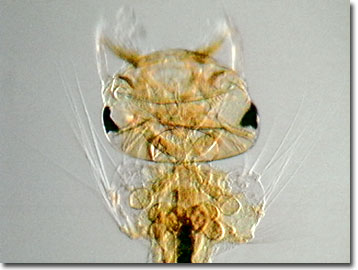Oblique Digital Image Gallery
Mosquito Larva
Mosquitoes in the genus Culex are found everywhere in the world except Antarctica. In the United States and Canada, 14 species swim and swarm, seeking to complete their life cycles with hapless abandon. Known to many as simply the "house mosquito", many species of Culex are known to breed in small, temporary water bodies including pet bowls, bird baths, and discarded automobile tires.

View a second image of a mosquito larva.
Larval mosquitoes are entirely aquatic and feature special adaptations for breathing underwater given their tracheal breathing system (sans gills). Instead of connecting to external paired spiracles along their body segments, mosquito larvae obtain air by poking a breathing or tracheal tube through the water surface. Known also as "wigglers", the larvae migrate vertically to obtain oxygen at the surface and are able to suspend themselves using the tension of the water-atmosphere interface. This requirement lends one clue to effective mosquito control without having to resort to hazardous insecticides. Coating the water surface with a surfactant or other impervious thin film will result in Culex larval suffocation and a vital break in their life cycle.
Although considered the bane of outdoor recreationists (because of the females' requirement for a blood meal before reproducing), mosquitoes provide benefits to aquatic and terrestrial ecosystems by converting paramecium and other first level consumers into high quality insect protein. Mosquito biomass supports predatory insects such as beetles and dragonflies as well as higher vertebrates including fish and many bird species. Known as disease vectors for several types of encephalitis and West Nile virus in temperate regions, and filariasis in tropical climates, humans are secondary to birds as blood sources for Culex. The control of mosquitoes is a multi-million dollar industry in the United States. Historically, the now-banned insecticide DDT was sprayed in neighborhoods, wetlands, and farms to kill mosquitoes. More recently, biological control with Bacillus thuringiensis, a naturally occurring soil bacterium that kills insect larvae, has garnered favor with local mosquito control agencies as well as with organic farmers.
Contributing Authors
Cynthia D. Kelly, Thomas J. Fellers and Michael W. Davidson - National High Magnetic Field Laboratory, 1800 East Paul Dirac Dr., The Florida State University, Tallahassee, Florida, 32310.
BACK TO THE OBLIQUE IMAGE GALLERY
BACK TO THE DIGITAL IMAGE GALLERIES
Questions or comments? Send us an email.
© 1995-2025 by Michael W. Davidson and The Florida State University. All Rights Reserved. No images, graphics, software, scripts, or applets may be reproduced or used in any manner without permission from the copyright holders. Use of this website means you agree to all of the Legal Terms and Conditions set forth by the owners.
This website is maintained by our
Graphics & Web Programming Team
in collaboration with Optical Microscopy at the
National High Magnetic Field Laboratory.
Last Modification Friday, Nov 13, 2015 at 01:19 PM
Access Count Since September 17, 2002: 21304
Visit the website of our partner in introductory microscopy education:
|
|
